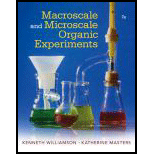
Macroscale and Microscale Organic Experiments
7th Edition
ISBN: 9781305577190
Author: Kenneth L. Williamson, Katherine M. Masters
Publisher: Brooks Cole
expand_more
expand_more
format_list_bulleted
Question
Chapter 4, Problem 4Q
Interpretation Introduction
Interpretation:
The reason for the use of smaller quantity of activated charcoal instead of its larger quantity should be determined.
Concept introduction:
Recrystallization is a technique that is used to purify the impure compounds. It is based on the principle that the solubility of substances increases with the increase in temperature.
Following are some of the types of recrystallization:
- Single-solvent recrystallization
- Multi-solvent recrystallization
- Hot filtration-recrystallization
Expert Solution & Answer
Want to see the full answer?
Check out a sample textbook solution
Students have asked these similar questions
Please correct answer and don't used hand raiting
At pil below about 35
woon (Fe) oxidizes in streams according to the following
Water in a reservoir at 20°C has a pH of 7.7 and contains the following constituents:
Constituent (g) + Conc. (mg/L)
Ca2+
38
HCO3 abiotic oxid 183
HO
Ferrous iron under these conditions and at 20°Cis
Estimate the activities of Ca2+ and HCO3-, using an appropriate equation to compute the
activity coefficients. (atomic weight: Ca 40)
draw the diagram please
Chapter 4 Solutions
Macroscale and Microscale Organic Experiments
Knowledge Booster
Similar questions
- Show work with explanation. Don't give Ai generated solutionarrow_forwardDraw the structure of the acetal derived from 2,2-dimethyl-1,3-propanediol and butanal. Click and drag to start drawing a structure. X G Parrow_forwardPredict the major products of the following reaction. 田 Be sure to use wedge and dash bonds to show the stereochemistry of the products when it's important, for example to distinguish between two different major products. 口 + X C₁₂ Click and drag to start drawing a structure.arrow_forward
- Explain how the equation 4Fe(OH)2(s)+O2(g)→2Fe2O3(s)+4H2O(l) in the article illustrates the oxidation of the iron in the rectants.arrow_forwardIf you wanted to make something out of metal but didn't want it to rust, what are your options?arrow_forwardExplain how the equation 4Fe(OH)2(s) + O2(g)→2Fe2O3(s) + 4H2O(l) in the article illustrates the oxidation of the iron ions in the reactantsarrow_forward
- A Predict the major products of the following reaction. Be sure to use wedge and dash bonds to show the stereochemistry of the products when it's important, for example to distinguish between two different major products. + Cl₂ 2 X Click and drag to start drawing a structure.arrow_forwardC app.aktiv.com Predict reagents needed to complete this E2 elimination reaction. Br Problem 17 of 40 H3O+ A heat NaH B heat 0 D E (CH)COK heat CH₂ONa (CH)COH heat Donearrow_forwardPlease correct answer and don't use hand ratingarrow_forward
arrow_back_ios
SEE MORE QUESTIONS
arrow_forward_ios
Recommended textbooks for you
 Macroscale and Microscale Organic ExperimentsChemistryISBN:9781305577190Author:Kenneth L. Williamson, Katherine M. MastersPublisher:Brooks Cole
Macroscale and Microscale Organic ExperimentsChemistryISBN:9781305577190Author:Kenneth L. Williamson, Katherine M. MastersPublisher:Brooks Cole

Macroscale and Microscale Organic Experiments
Chemistry
ISBN:9781305577190
Author:Kenneth L. Williamson, Katherine M. Masters
Publisher:Brooks Cole